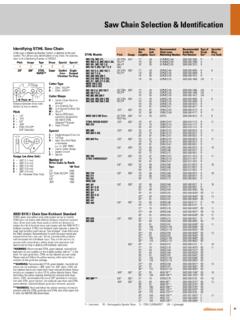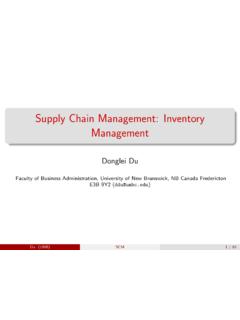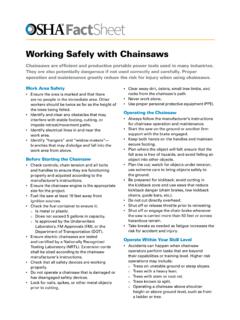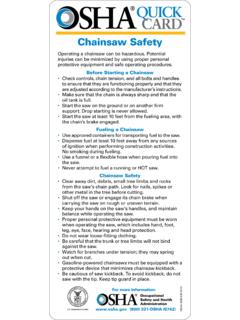Transcription of CHAPTER A
1 Speech and Language Processing. Daniel Jurafsky & James H. Martin. Copyright 2021. Allrights reserved. Draft of December 29, Markov ModelsChapter 8 introduced the Hidden Markov Model and applied it to part of speechtagging. Part of speech tagging is a fully-supervised learning task, because we havea corpus of words labeled with the correct part-of-speech tag. But many applicationsdon t have labeled data. So in this CHAPTER , we introduce the full set of algorithms forHMMs, including the key unsupervised learning algorithm for HMM, the Forward-Backward algorithm. We ll repeat some of the text from CHAPTER 8 for readers whowant the whole story laid out in a single Markov ChainsThe HMM is based on augmenting the Markov chain .
2 AMarkov chainis a modelMarkov chainthat tells us something about the probabilities of sequences of random variables,states, each of which can take on values from some set. These sets can be words, ortags, or symbols representing anything, like the weather. A Markov chain makes avery strong assumption that if we want to predict the future in the sequence, all thatmatters is the current state. The states before the current state have no impact on thefuture except via the current state. It s as if to predict tomorrow s weather you couldexamine today s weather but you weren t allowed to look at yesterday s (a)(b)Figure Markov chain for weather (a) and one for words (b), showing states andtransitions.
3 A start distribution is required; setting = [ , , ]for (a) would mean aprobability of starting in state 2 (cold), probability of starting in state 1 (hot), formally, consider a sequence of state variablesq1,q2,..,qi. A Markovmodel embodies theMarkov assumptionon the probabilities of this sequence: thatMarkovassumptionwhen predicting the future, the past doesn t matter, only the Assumption:P(qi=a| 1) =P(qi=a|qi 1)( )Figure shows a Markov chain for assigning a probability to a sequence ofweather events, for which the vocabulary consists ofHOT,COLD, andWARM. Thestates are represented as nodes in the graph, and the transitions, with their probabil-ities, as edges.
4 The transitions are probabilities: the values of arcs leaving a given2 APPENDIXA HIDDENMARKOVMODELS state must sum to 1. Figure shows a Markov chain for assigning a probabil-ity to a sequence of This Markov chain should be familiar; in fact,it represents a bigram language model, with each edge expressing the probabilityp(wi|wj)! Given the two models in Fig. , we can assign a probability to anysequence from our , a Markov chain is specified by the following components:Q= set ofNstatesA= probability matrixA, eachai jrepresent-ing the probability of moving from stateito statej, nj=1ai j=1 i = 1, 2,.., Naninitial probability distributionover states.
5 Iis theprobability that the Markov chain will start in statesjmay have j=0, meaning that they cannotbe initial states. Also, Ni=1 i=1 Before you go on, use the sample probabilities in Fig. (with = [.1,.7.,2])to compute the probability of each of the following sequences:( ) hot hot hot hot( ) cold hot cold hotWhat does the difference in these probabilities tell you about a real-world weatherfact encoded in Fig. The Hidden Markov ModelA Markov chain is useful when we need to compute a probability for a sequenceof observable events. In many cases, however, the events we are interested in arehidden: we don t observe them directly. For example we don t normally observehiddenpart-of-speech tags in a text.
6 Rather, we see words, and must infer the tags from theword sequence. We call the tagshiddenbecause they are not Markov model(HMM) allows us to talk about bothobservedeventsHiddenMarkov model(like words that we see in the input) andhiddenevents (like part-of-speech tags) thatwe think of as causal factors in our probabilistic model. An HMM is specified bythe following components:Q= set ofNstatesA= probability matrixA, eachai jrepresenting the probabilityof moving from stateito statej, Nj=1ai j=1 iO= sequence ofTobservations, each one drawn from a vocabularyV=v1,v2,..,vVB=bi(ot)a sequence ofobservation likelihoods, also calledemission probabili-ties, each expressing the probability of an observationotbeing generatedfrom a statei = 1, 2.
7 , Naninitial probability distributionover states. iis the probability thatthe Markov chain will start in statei. Some statesjmay have j=0,meaning that they cannot be initial states. Also, ni=1 i=1A first-order hidden Markov model instantiates two simplifying THEHIDDENMARKOVMODEL3 First, as with a first-order Markov chain , the probability of a particular state dependsonly on the previous state:Markov Assumption:P(qi| 1) =P(qi|qi 1)( )Second, the probability of an output observationoidepends only on the state thatproduced the observationqiand not on any other states or any other observations:Output Independence:P(oi| ,..,qT,o1,..,oi,..,oT) =P(oi|qi)( )To exemplify these models, we ll use a task invented by Jason Eisner (2002).
8 Imagine that you are a climatologist in the year 2799 studying the history of globalwarming. You cannot find any records of the weather in Baltimore, Maryland, forthe summer of 2020, but you do find Jason Eisner s diary, which lists how many icecreams Jason ate every day that summer. Our goal is to use these observations toestimate the temperature every day. We ll simplify this weather task by assumingthere are only two kinds of days: cold (C) and hot (H). So the Eisner task is asfollows:Given a sequence of observationsO(each an integer representing thenumber of ice creams eaten on a given day) find the hidden sequenceQof weather states (H or C) which caused Jason to eat the ice shows a sample HMM for the ice cream task.
9 The two hidden states(H and C) correspond to hot and cold weather, and the observations (drawn from thealphabetO={1,2,3}) correspond to the number of ice creams eaten by Jason on agiven day. = [.2,.8]HOT2 COLD1B2P(1 | HOT) .2P(2 | HOT) = .4P(3 | HOT) . (1 | COLD) .5P(2 | COLD) = .4P(3 | COLD) .1B1 Figure hidden Markov model for relating numbers of ice creams eaten by Jason (theobservations) to the weather (H or C, the hidden variables).An influential tutorial by Rabiner (1989), based on tutorials by Jack Ferguson inthe 1960s, introduced the idea that hidden Markov models should be characterizedbythree fundamental problems:Problem 1 (Likelihood):Given an HMM = (A,B)and an observation se-quenceO, determine the likelihoodP(O| ).
10 Problem 2 (Decoding):Given an observation sequenceOand an HMM =(A,B), discover the best hidden state 3 (Learning):Given an observation sequenceOand the set of statesin the HMM, learn the HMM already saw an example of Problem 2 in CHAPTER 8. In the next two sectionswe introduce the Forward and Forward-Backward algorithms to solve Problems 1and 3 and give more information on Problem 24 APPENDIXA Likelihood Computation: The Forward AlgorithmOur first problem is to compute the likelihood of a particular observation example, given the ice-cream eating HMM in Fig. , what is the probabilityof the sequence3 1 3? More formally:Computing Likelihood:Given an HMM = (A,B)and an observa-tion sequenceO, determine the likelihoodP(O| ).



















